The 10 Cleverest Internet Films of 2012
by Eric Spiegelman
For the last two years, I dedicated this list to videos that stirred the heart. This year’s list is made up of those films that give the mind a little twist, providing that tiny moment of escape that comes from seeing things a bit differently than usual. These are the ten cleverest Internet films to cross my various social media dashboards over the past year. They’re presented here in no particular order, although the first one is a particular favorite.
• Jake Dolgy & Jake Ross might be the first directors in history to accurately portray people using the Internet in a fictional film. In “Online Now” (above) there are no beeping keystrokes, no animated envelopes to indicate an email is being sent, and no law enforcement officers demanding “enhance!” Instead, there are people so immersed in their mobile devices in public that they appear as zombies, singles who manage their online personae in the hope of getting laid, and commenters who objectify someone at her most vulnerable. And then, alongside all of the gross and dissociated Internet habits, the two Jakes show the one thing that redeems the entire medium — the Internet can make you feel less alone.
• Clever is something we reward. This is especially true in advertising. Two of the most clever videos this year were selling something. The first one, “Henry & Aaron — IT’S A SNAP!” did not work on me. I will not be matriculating to the Central Institute of Technology. But that’s mostly because I have enough degrees already and I don’t live in Australia.
• The second one, though, did work on me. I am now a proud member of the Dollar Shave Club. And I’m not the only one. This video, “DollarShaveClub.com — Our Blades Are Fucking Great,” was so immensely popular that the Dollar Shave Club team was caught off-guard by their own success. In an email sent to customers a week after the video went viral, they confessed how unprepared they were, noting that their entire shipping department consisted of a single Dymo LabelWriter 450.
https://www.youtube.com/watch?v=ZUG9qYTJMsI
• Speaking of videos that sell something, 2012 was an election year. I could write an entire ebook about the satirical political videos that competed for our attention over the past twelve months, but, mercifully, I will not. Instead I will highlight just one, the most clever of the lot: this Mitt Romney campaign ad beautifully recut by YouTuber Hugh Atkin, which he calls “Song of Mitt’s Self.” It is a masterwork. “I think the American people have different views, and I agree with the American people!” Indeed, sir. Indeed.
• This year, BuzzFeed hired the high priest of clever Internet videos, Ze Frank, to work his brilliance on its YouTube account. One of his first productions there hit the bulls-eye right in the center. “The Perfect Guide to Holiday Etiquette” is indeed perfect in its simplicity — it’s really just a couple dozen shots of a plate with food on it — and the hilarity that derives from this is what makes it so .
• Next on the list is a favorite YouTube talent. His account name is ignoramusky, he’s Russian, and he takes cat videos and gives them a full musical score, edited to the action of the video, often ominously so. This year he returned with another amazing work in the genre, a 20-second thriller entitled, “The Cat Is Planning Something Evil.” It’s impossible to watch this fewer than a hundred times.
• There is so much to like about this next one, a sketch from the team at College Humor called “Batshit Crazy Acting Teacher,” made in the style of a PBS educational series. This is my favorite funny video of the year. It’s the most precise satire of an acting teacher I’ve ever seen — but that’s only part of the reason it made this list. The thing that elevates this video over all the other clever sketches I saw online this year is the meatball joke, which kills me.
• A year ago, I declared that the genre of the time-lapse video had achieved everything it could possibly achieve. I was wrong. So wrong, in fact, that the three videos left in this list are all time-lapse videos. Each one succeeds in a different way, and each is uniquely clever. The first, “Rear Window Timelapse,” by Jeff Desom, does something that nobody has ever done before. The video is essentially a diorama constructed entirely out of scenes from Alfred Hitchcock’s Rear Window, showing what the actual, complete view from Jimmy Stewart’s rear window looked like.
• I’ve seen just about every film that treats the city of Los Angeles as a living character in the script. Usually the city is glorified, in an almost apologetic attempt to rebut its negative stereotypes. But no cinematic work has ever portrayed Los Angeles as beautifully as “Nightfall” by Colin Rich, the second time-lapse to make this list.*
• The final cleverest video of 2012 isn’t particularly clever in its execution. It’s a time-lapse, as previously stated, and time-lapses, as also previously stated, have mostly been done to death. This one stands out for two reasons, however. First, it tells the story of one of the most delightfully clever little engineering feats of the year, the navigation of the Space Shuttle Endeavor through the streets of Los Angeles. Second, I’m pretty sure it counts as journalism — which seems so obvious a purpose for time-lapse photography that I’m surprised I can think of so few examples of it. In fact I can only think of one other — the new film Chasing Ice, which might be the first time-lapse feature documentary. So with that, I leave you to marvel at the incongruity of the Space Shuttle gliding below an apartment window, as captured by the Los Angeles Times videoographer Brian Chan. (Click the photo to go to the LA Times site and watch the full video.)

* City of Angels, from 1998, is a close second.
Previously in 2012 In Review: The Year In Internet Outrage
Eric Spiegelman is a web producer in Los Angeles and the proprietor of Awl Music.
New York City, December 20, 2012

★ Predawn darkness held on so long that the day seemed overcast, a false impression that would soon enough be true. Daylight did come, long enough to shine glassily on the Hudson and illuminate a passing airplane. Then the shroud: gray overhead, yellow downtown, and one briefly surviving band of blue uptown. At half past noon, the light was already failing, into an afternoon of edgeless clouds, directionless dim light, seeping chill. Sometime in after evening, rain must have fallen; on the way to the drugstore, the dark pavement was covered with wet grime. A rat crossed the sidewalk, from gutter to rubble pit. The last rat of autumn.
Football Pick Haikus For Week 16
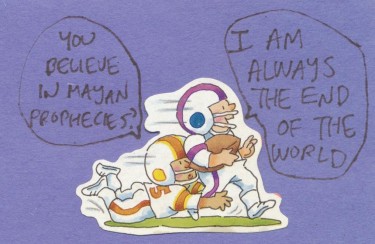
Saturday, December 22
Atlanta -3.5 At Detroit
Detroit really needs
a new city government
and a new head coach. PICK: FALCONS
Sunday, December 23
At Green Bay -12.5 Tennessee
I’d take the Titans
and the points if you gave me
seven billion points. PICK: PACKERS
At Carolina -8 Oakland
Newton will be worst
thing to happen in Oakland
since their Occupy. PICK: PANTHERS
At Miami -4.5 Buffalo
Yes, I still Bill-lieve.
Because C.J. Spiller can
keep this crap game close. PICK: BILLS
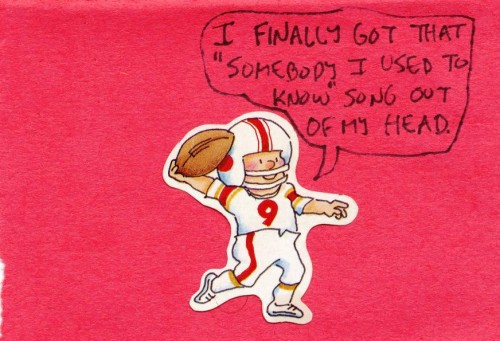
At Pittsburgh -3.5 Cincinnati
The Steelers will no
doubt somehow win this I just
haven’t figured how. PICK: STEELERS
New England -14.5 At Jacksonville
Fifteen points is
pretty good but the Pats love
to run up the score. PICK: PATS
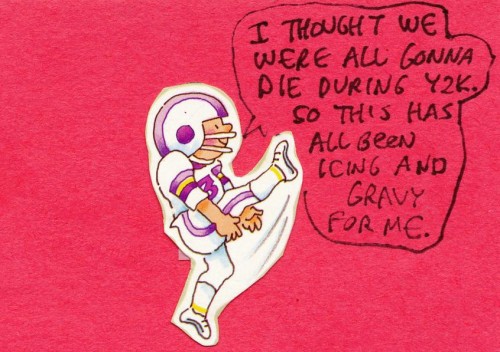
Indianapolis -7 At Kansas City
Somewhere right now a
child is being born that will
be a sad Chiefs’ fan. PICK: COLTS
At Dallas -3 New Orleans
Keep throwing the ball
to Dez Bryant and Cowboys
will only lose by 6. PICK: SAINTS
Washington -6.5 At Philadelphia
They don’t need Griffin.
Redskins could win this game with
eleven punters. PICK: REDSKINS
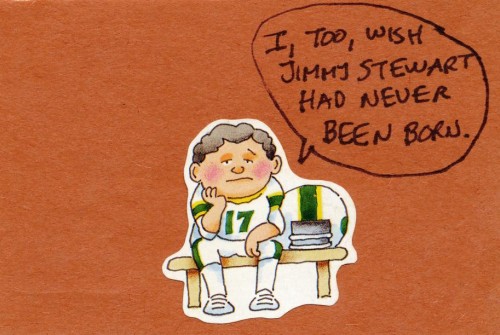
At Tampa Bay -3 St. Louis
If Rams can rush the
Bucs’ quarterback they can hang
around in this one. PICK: RAMS
NY Giants -2.5 At Baltimore
Eli Manning will
awaken from his coma
against Crypt Keepers. PICK: GIANTS
At Houston -7.5 Minnesota
Texans just need to
stop Adrian Peterson.
Can you guys do that? PICK: TEXANS
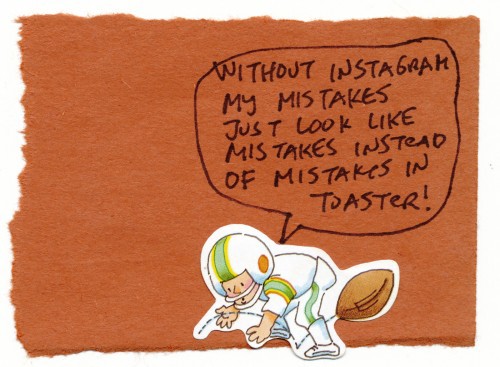
At Denver -13 Cleveland
Take the points! The Browns
keep games close even if they
can’t win on the road. PICK: BROWNS
Chicago -5.5 At Arizona
Bears will win because
the Cardinals offense is worse
than scorpion poo. PICK: BEARS
San Francisco -1 At Seattle
No team comes to the
Emerald City and gets
out unrained upon. PICK: SEAHAWKS
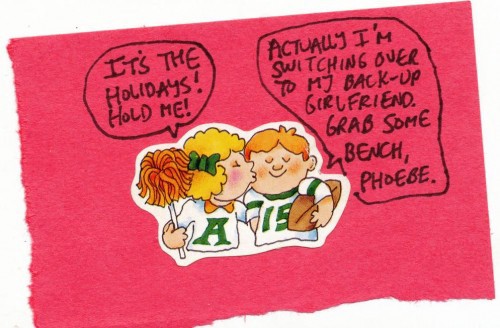
At NY Jets -2.5 San Diego
Jets will probably
win then Sanchez probably
sleeps with your sister. PICK: JETS
Last week’s Haiku Picks went 8–8. We can make it up in the playoffs. That’s 104–116–5 for the season.
Jim Behrle tweets at @behrle for your possible amusement. Pick up the GQ with Bill Murray on the cover to never be able to erase the mental image of Behrle’s sex face from your mind.
'Not Fade Away': 5 Years After 'Sopranos,' Does David Chase Still Hate People?
‘Not Fade Away’: 5 Years After ‘Sopranos,’ Does David Chase Still Hate People?
by Amy Monaghan and Sean Burns

Amy Monaghan: Talk to me about how, as a “Sopranos” fan, you felt about the news of a David Chase movie at long last, the coming-of-age-in-Jersey film Not Fade Away, which we are here to dismantle today.
Sean Burns: Mostly I wondered what took him five years. I knew Chase had taken off to France for a while, presumably hiding from the folks with torches and pitchforks after that “Sopranos” finale. But he has such a distinctive cinematic sensibility, I thought he’d be making movies a lot sooner.
Amy: His distinctive cinematic sensibility? Remember, I’m the only person on the planet to never watch “The Sopranos.” No, wait, I did see one episode. Annabella Sciorra was Tony’s mistress and met a bad end, I think?
Sean: Yeah, have I nagged you about that lately?
Amy: Fuhgettaboutit. Listen, right after I read Ulysses and Infinite Jest, I am ON IT.
Sean: What I think confounded people about “The Sopranos” was that Chase viewed the gangsters and goombahs milieu through the prism of 1960s European art cinema. The edits were elliptical, storylines abruptly abandoned, and he was never afraid to dive into surrealism. The show’s sometimes terrifyingly evocative (and other times hilarious) dream sequences were a constant thorn in the side of viewers who just wanted to watch people get whacked.
Amy: As one does. OK, so he’s not afraid of ambiguity and pissing people off. In fact, when we first talked about Not Fade Away, you told me “I think Chase just hates people.”
Sean: Well, “The Sopranos” is my favorite show ever because I feel like it captures a cultural moment, a nagging existential dissatisfaction in the midst of lavish material excess. So much of the show is about consumption and waste. There’s more eating and shitting on this show than we ever saw on television.
Amy: You can’t have Italian Americans without eating.
Sean: And the arc of the series, particularly the final season, saw every one of the rotten, soul-sick characters given a second chance to change their lives and (possibly) redeem themselves. But after a bit of lip service they all went right back to what was most convenient. Which in the case of this show meant either crime or, best-case scenario, severe moral compromise. So yeah, I don’t think Chase has a particularly sunny view of humanity.
Amy: Let’s artfully segue from dissatisfaction to how Not Fade Away begins. A televised emergency broadcast system siren bleeds into the Rolling Stones’ “(I Can’t Get No) Satisfaction” on the soundtrack. How would you rate your anticipation/giddiness at that opening moment, having waited for five years?
Sean: It might be my favorite metatextual gag since David Lynch smashed a TV in the opening shot of the Twin Peaks movie.
Amy: Yeah, but “Satisfaction,” of all songs? (Eyeroll) I mean, aside from advertising from note one that this movie had an ENORMOUS music clearance budget, why go for the Time-Life greatest hit of hits? (Caveat: I may still nurse a grudge about Chase disinterring that fucking Journey song from where I’d happily left it, at high school dances.)
Sean: If you’re going to play around with iconography, might as well aim high.
It’s a strange film, and I don’t think it entirely works, but I can see what he was attempting.
Amy: Which is?
Sean: This is a very familiar story, so familiar that he skips across the predictable beats in an elliptical fashion, focusing mostly on odd details. It feels very much like a personal remembrance using a hackneyed formula as a mere clothesline.
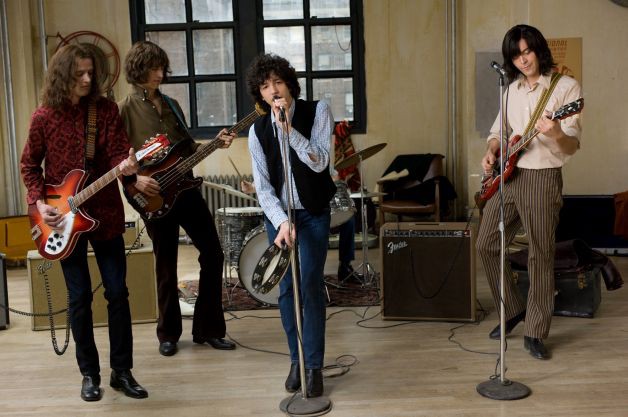
Amy: Gotcha. So, familiar story: Douglas (John Magaro) and his friends Eugene (Jack Huston) and Wells (Will Brill) start a band in 1960s New Jersey. They practice. They work shitty jobs and/or go off to college. They play a house party. They pine after Grace (Bella Heathcote with bangs that walked right off the sleeve of The Freewheelin’ Bob Dylan, perhaps prompting Douglas to later sport a Bobby Z. perm?). There are rivalries, family strife, Vietnam obliquely, college, weed, dropping out, ventures into Manhattan, and almost but not quite “making it.”
Sean: I gather that you hated it.
Amy: No, I didn’t hate it. I was impatient with it. Of COURSE there’s the beautiful girl the shy drummer longs for who only looks his way once he starts singing lead. Maybe I also agreed with the father, Pat (James Gandolfini), that Douglas could be a whiny little prick. Tell me about the family dynamic in Not Fade Away vis-a-vis your beloved “Sopranos” template. There’s the “Chase and Gandolfini, together again” aspect, of course. But what the fuck does Chase have against mothers?
Sean: His mother issues are a topic not even years of therapy and a long-running television program could even begin to unpack, obviously. But yes, I agree with you that the kid could indeed be a whiny little prick — which is something you never see in semi-autobiographical memory flicks like this. Filmmakers are usually trying so hard to idealize their childhood selves, but in this case Douglas is terribly short-sighted and can be more than a little bit of an asshole.
Amy: That whole scene when he comes back for the holidays and pitches a fit at the dinner table, all “The BAND’S my family now.” Oof.
Sean: The kids in this movie are a lot like Meadow and A.J. on “The Sopranos,” so self-obsessed they’re often oblivious to anything outside their tiny universe.
Amy: Even Vietnam. Or the civil rights movement.
Sean: Exactly. The Kennedy assassination barely even registers with the kids in this movie.
Amy: Well, the movie starts just after. But yeah, I feel like Chase drops in these shriekingly obvious “here’s what’s happening in the world” markers, usually via the television, so we have a sense of what time it is outside of their bubble. Like the girls watching the Stones perform on television in a room smeary with cigarette smoke or Douglas heading to Los Angeles of COURSE right as RFK’s ready to make his speech/get assassinated.
Amy: Oh, hey, can we talk about Grace’s sister? The “Jenny” a la Forrest Gump embodiment of THE COUNTERCULTURE???
Sean: Not my favorite subplot. Her scenes are played a lot broader than the rest of the picture.
Amy: She LIVES IN THE VILLAGE. She DOES DRUGS. She PAINTS FUCKED-UP PICTURES. Why have her in the movie? Is she meant to suggest that even beautiful, rich Grace has depth and problems? How does she fit into your larger understanding of the Chase-i-verse?
Sean: Well, I originally thought she was so overscaled to suggest the exoticism of older sisters in the world of teenage boys.
Amy: Ah, that I would actually buy. Along with suggesting that even a rich, country club family and not just Pat the Pep Boy employee’s goombah brood is confounded by the changing culture?
Sean: Yeah, and it is classic Chase that her flower-power slogans are often risible. He’s remembering a time while being a bit too clear eyed to idealize anything. Well, anything except the music.
Amy: Yes, the music. When I saw Not Fade Away at the New York Film Festival, Little Steven, resplendent in purple from pirate headscarf to suede booties, was part of the post-screening press conference. He and Chase talked about how rock n’ roll comes out of places like suburban Jersey because there are cars and garages there. What did you think of the practice/performance scenes?
Sean: I assume Little Steven coached them to death, because I was convinced. What I enjoyed about that aspect of the movie is the dearly now out-of-fashion idea of rock ’n’ roll as an agent of liberation and escape.
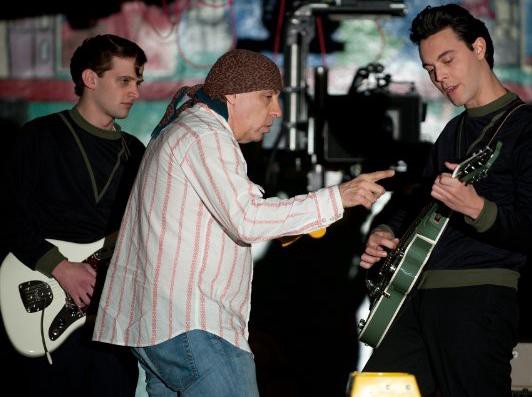
Amy: Little Steven said he ran a boot camp, after Chase ignored his plea to cast musicians who could act. And I agree, there’s something urgent and vital about a Bo Diddley drum beat that can’t be denied.
Sean: At that age, when you are just forming your identity, isn’t it natural to define yourself at least in part by what kind of music you listen to?
Amy: Oh, DEFINITELY. This is my tribe, my people. Beatles or Stones? These are life-and death-fealties, for sure. And, I guess, Not Fade Away being essentially a Stones picture would explain the more bluesy longueurs of the pacing overall? Because you’d think 4/4 rock might otherwise impose a more uniform rhythm.
Amy: What about when the band plays the house party the first time they and their classmates are back home from college for the holidays? Douglas steps in after lead singer Eugene swallows a joint and sings “Time Is On My Side” while following Grace’s movement through the party.
Sean: That’s a lovely scene.
Amy: Indeed. And then there’s Lee Hazlewood’s “Some Velvet Morning” later on, not played by the band but underpinning a motorcycle accident. (And I just gotta say, after Dylan, of COURSE there’s a motorcycle accident.)
Sean: A remarkably low-stakes motorcycle accident involving a garden gnome.
Amy: Ahem, shouldn’t you say “spoiler alert” or something? But going back to that party, I loved how quickly Douglas’s post-performance high crashes when Grace says she’s dating an adjunct professor of medieval Persian poetry. I mean, of course she is. That’s what unattainable girls like that do after they graduate from dating high-school jocks.
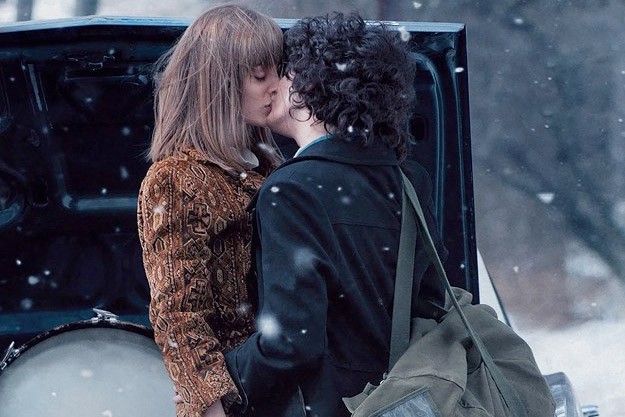
Sean: I think the hugeness of the music is at times a very funny contrast with the smallness of these characters and their limited world.
Amy: Yes, that “hugeness.” I think the aggressiveness with which this era’s music has been telling us how to feel for 50 years now might have something to do with that impatience I felt. Also, during the press conference, Boomers in the crowd asked questions that congratulated themselves on their musical taste and breathlessly asked the 80s-born actors, how could you possibly channel the AWESOMENESS of this era you missed but have had shoved down your throat as the sine qua non of AWESOMENESS ever since.
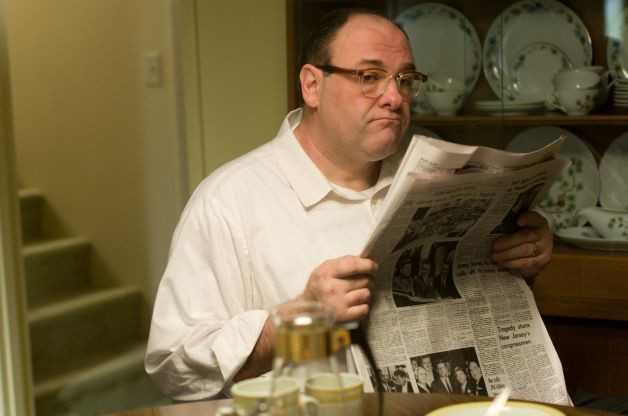
Sean: There’s nothing that makes my teeth itch worse than Boomer nostalgia. But it’s not like we’re talking about Across the Universe here or a Robert Zemeckis film. Look at James Gandolfini, who is actually wrestling with far more serious crises and even life-and-death concerns that his son barely notices.
Amy: True. Douglas essentially shits on his father Pat’s dream of upward mobility for his kids by dropping out of college, and they remain at an impasse until that scene in the restaurant. I understood then why you-all revered Tony Soprano so.
Sean: Gandolfini’s on a remarkable run right now, stealing scenes in Zero Dark Thirty and walking away with Killing Them Softly. What I enjoyed was how much more layered Pat was than the usual “disapproving father” cliché, despite dropping racist and homophobic slurs during the family cookout.
Amy: Do you think having Pat’s big moment of treating his son like the man of the family — at a restaurant — gives “Sopranos” fans a little gift since they left Gandolfini in that diner so abruptly five years ago?
Sean: I love that diner scene so much (yes, even the Journey song) that I want Tony to stay in limbo there forever. But what I think the restaurant scene here does — by far the best scene in the movie — is capture that moment growing up when you discover that your father actually once had his own life beyond just caring for your family, which always feels like such a shock even though it obviously shouldn’t.
Amy: Oh, I agree. And it is so much more compassionate about the generational divide than anything else the movie gives us. Here is a man with regrets and never-disclosed passions who follows the code of responsibility to his family even as he admires Douglas’s relative freedom to follow Grace and his dreams out to California. And the grace-note shot of him watching “Bali Ha’i” from South Pacific on television while his shrewish wife sleeps on the sofa beside him… chills.
Amy: I suspect that set of scenes also brings us back to what you said earlier about Chase and 60s art films. Douglas complains when he’s watching Blow-Up with Grace (because what young man hasn’t endured an art movie to impress a girl?): “Nothing happens and there’s no orchestra to tell you to watch out, this guy’s gonna get killed.”
Sean: That’s a bingo. And after five years people are still trying to “prove” whether or not Tony Soprano died in that diner, as if a work of art is a puzzle that can be solved.
Amy: Listen to you, sounding like something out of the nouvelle vague! I loved Grace’s answer, too: “I think the trees are the music.” Which brings me to the movie’s final set piece, when Douglas goes to California with the (David Chase-ian) idea of “putting music together with film images.” There’s some of that leaden stuff that irks me for being too telegraphed: a marquee advertising The Graduate and shots of the Capitol Records building as ubiquitous as the Eiffel Tower in a Paris-set picture. But then there’s that ENDING. What in the hell do you think viewers are gonna do with that?
Sean: I have a sneaking, completely un-provable suspicion that Little Steven wrote that closing line, because it sounds exactly like stuff he says on his radio show all that time. That said, I thought it was unfortunate but salvaged by the closing credits in which the Sex Pistols play behind a vintage “American Bandstand” clip, and the music and movements are weirdly in sync — suggesting a continuity through the generations. But before that… um, yeesh.
Amy: Yeesh “the younger sister dancing” or yeesh “Roadrunner”?
Sean: The younger sister.
Amy: Oh, good, because “Roadrunner” redeemed it for me, although obviously not completely. It was not just beautifully leftfield. (Although when Chase was asked why he closed with a song that chronologically anachronistic, he said, “I like that song.”) What I really loved about the choice is that “Roadrunner” launches into orbit with Jonathan Richman’s exhilarating count-off, which I think Greil Marcus writes about as a crucial turning point for popular music: “One-two-three-four-FIVE.”
Sean: Oh, that wasn’t the Sex Pistols version?
Amy: Shit, I think it might be. But even so, I felt as though I could breathe again. So, is this the sort of movie people should see with their Boomer parents on Christmas?
Sean: They’ll probably want to see that fucking thing with Billy Crystal and Bette Midler, instead.
Amy: Or Streisand and Rogen. But, I guess, if you must see only one movie where non-musicians sing… give me Little Steven over sub-par Susan Boyle.
Under her own name and as the Cinetrix, Amy Monaghan has been writing on the Internets since 2003. A senior lecturer in film studies and literature, she probably should be grading papers right now.
Sean Burns writes for Philadelphia Weekly and The Improper Bostonian. He catches it all at Spliced Personality.
Merry Christmas: Pope Rallies World's Infidels Against Gays

What’s the pope up to, this Christmas? Oh, just rallying the world’s other intolerant religious leaders against the global menace of gay people registering at Macy’s. Nothing says “Peace on Earth and good will towards men” like a yuletide jihad against same-sex marriage — because if there’s anything the story of Christ’s birth teaches us, it’s to stigmatize and then attack people who lack legal and societal protections.
Pope Benedict on Friday signaled the Vatican was ready to forge alliances with other religions against gay marriage, saying the family was threatened “to its foundations” by attempts to change its “true structure.”
The pope’s latest denunciation of gay marriage came in a Christmas address to Vatican officials in which he blended religion, philosophy, anthropology and sociology to illustrate the position of the Roman Catholic Church.
The old saying about “obsessive hatred of gays makes for strange bedfellows” is certainly true today, as a wicked old man in a bejeweled dress takes a break from protecting his church’s child molesters to join France’s chief rabbi in a worldwide campaign against homosexual couples. Wasn’t the Vatican still blaming the Jews for “murdering Jesus” until fairly recently, like when Pope Joseph Ratzinger was just another young Nazi soldier with a crazy dream?
The Vatican is even teaming up with its chief enemies for the past millennium, the Muslims. People who worship other gods may be going to Hell forever, according to Catholicism, but they can be roped into opposition of pro-gay legislation wherever it pops up. Muslims in Scotland are a recent example of the Vatican encouraging infidels to protest a government’s tolerance.
The Pope used his Christmastime speech to propagandize for adherence to the “preordained duality of man and woman,” or the same male-female coupling the church prohibits for its male clergy, because they are supposedly married to Christ, which is a blatantly gay concept. “When such commitment is repudiated,” Benedict said, “the key figures of human existence likewise vanish: father, mother, child. Essential elements of the experience of being human are lost.”
No wonder priests are so messed up! They’ve been denied the “essential elements of the experience of being human.” This happens when people are denied their “nature,” doesn’t it? Luckily, there is an easy way to solve the problem and let people have the rich interpersonal lives that God wants for all of us, even Muslims and Jews: Encourage people to marry the spouse of their choice.
The Odious Tyranny Of Chain Restaurant Middle Managers
by Mobutu Sese Seko
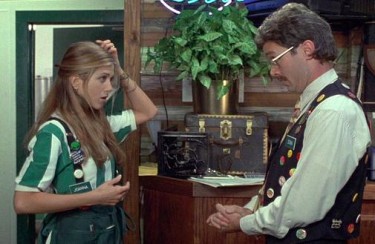
Months ago, I let a rich guy with an expensive haircut persuade me to let him cut open my abdomen in four places. Sure, this was for legitimate “medical reasons” that made me vastly safer in the long term, but agreeing to schedule this event the week before Thanksgiving was… dumb. Walking around with enough stitches to cosplay as an NFL football sucks under any circumstance, but it’s especially shortsighted just before American citizens play Build-a-Blimp with their belly areas.
Since I couldn’t heave big baking pans or screw around with the barbecue pit without agony, this led the family members who came down to visit me to take me out for a lot of lunches and dinners. When the host is wounded, it’s easier to make food someone else’s problem. And maybe this is the sort of development that only seems odd when you’re being chauffeured around in a smiling Percocet haze, but it seems like mid-price American family restaurants have standardized the “platoon of unctuous/obnoxious turd managers who come by your table to verify that your server isn’t clinically braindead.”
At any other time of the year, these are people we calmly and confidently refuse to take seriously under any circumstance, but the holiday season erodes even the most cultivated indifference. Because of expenses, travel inconveniences, time crunches and especially family, the next two weeks teem with recrimination and emotional violence. And — precisely because family knows where we live, sometimes lends us money and can remember that time we ran around the backyard with socks on our hands, a hat that read “AWESOME COUGARS” and our genitals flapping (or not) in the breeze — we tend to direct this simmering ill-will outward, at anyone but those responsible. People like the waiters and waitresses who help funnel sweet tea and sodas into us, whose managers come strollin’ by our table, hoping we’ll snitch.
What brought this home was a Thanksgiving visit to a burger joint and a management culture that at best vacillated between live-action questionnaire and employee surveillance state.
(Before we go much further, let me please try to blame almost everything on surgery and drugs. I like to think I’m a good relative, and my idea of entertaining people from out of town isn’t usually, “Have you tried ground beef? What about with bread? Oh, my God, it’ll blow your mind. We can also have it with water that’s been poured through leaves, chilled and sweetened. Here, put these earbuds in, and dig on this Shins song, because everything is about to change your life.”)
Unfortunately, I needed to be someplace where the food wasn’t exotic and intestinally torturous, and it needed to be in an atmosphere where some guy just passing out while sitting upright or needing to puke his guts out wouldn’t be, like, gauche or anything. So family style and burgers it was. Even though they totally have turkey and venison and buffalo burgers. And localvore veggies. And elk. FUCK ELK.
Being observed by wait staff is natural. I welcome it. It is a delicate dance that has evolved over centuries. I try to eat my food, and the server lurks behind pitchers of tea at the wait station until the moment I am the most unforgivably gross. He or she approaches the table as ketchup is smeared across my face like I just drunkenly made out with the graduating class of the clown college. He or she smirks at me, as if to say, “You and I… we are playing a little game, ah?” before asking if everything is OK and if I want more tea. I haplessly grunt, “Mmmph!” and gesture in a vague tribal fashion with a hand that even then is trickling burger grease down its side, under my watch band and deep beneath my cuffs. I am disgusting. The server has won.
Managers coming by merely queers the purity of the turf. THIS IS A NOBLE GAME, and it’s being sullied by this layer of supervision wholly unnecessary to the eating/embarrassment process. It’s also hard not to think a few things:
1. “I must look like an idiot.”
Generally speaking, Americans aren’t terribly shy when it comes to complaining about shit. We’re capable of conflating the most innocuous setbacks with great miscarriages of justice — like, depending on your point of view, this entire column. (See also: “Thanksgiving, The Ordeal Of”.) So the fact that there’s an entire extra supervisory layer dedicated to making sure your meal is satisfactory implies that you’re terminally meek or a bozo or both. If your burger was little more than half-ground connective tissue and ancient ski-lodge carpet shavings served in ice-cold puck form, you probably have the courage to say, “Now hold on just a damn minute,” even if your server is radiantly cute.
Speaking of which:
2. The restaurant management layer seems conspicuously male.
Obviously, my drug-addled trip through suburban dining-out options was anything but scientific, but this was something I noticed even when I used to work in restaurants — back when my priorities were getting a good score on the SAT and fixing the CD player in the silver Camry (a.k.a. the EFFICIENT LOVEWAGON). Your wait staff at family restaurants seems dominated by girls and a few older women — the Department of Labor shows that women account for over 70% of server positions — and it’s always both disappointing and sort of creepy that their immediate bosses all seem to be dudes in their early thirties who bathe each morning in some kind of scent named after a store that primarily sells pants. It’s hard not to get a whiff of the faintly bro-ishly exploitive from the power structure.
3. I am not your goddamn informant.
Back when I worked in restaurants, I lucked out and eventually got two great managers — one man, one woman. (This was out of half a dozen places. The woman, for the record, was the only woman manager.) They encouraged staff to get their attention when customers seemed unhappy. A comped drink or appetizer could placate almost anyone, assure repeat business and prevent customers from taking their frustrations out on the tip portion of the meal. Further, they reasoned, rightly, that someone in a position of authority was less likely to suffer a torrent of abuse than some kid trying to earn gas money. This is the way that managers hovering around the dining floor is supposed to work, and I suspect that it was the original intent behind following up on servers.
But it’s also easy to see what it nastily can become, in the hands of cynically exploitive or essentially lazy management — an effort-free means of employee intimidation and quality control. You can watch your waitress cast a glance over her shoulder at your table when the manager comes up to doublecheck on her. Suddenly she’s probably working with a stiffer back and robotically going through some acronym-based U.P.S.E.L.L. management routine — to your manifest annoyance, even if you’re a regular — while Herr Direktor of Scampi’s Bottomless Family Shrimpfest airily wanders around the tables, contributing dick-shit. And worst of all, that kind of informant-fueled manager enables every petty, mean, vengeful streak in the entitled American character. Complaining directly to servers requires at least the confidence that you are right, that they screwed up and that your halting them to say, to their faces, that they are doing a poor job is earned. But bitching someone out to a third party is easy. You can make shit up and score a free Awesome Blossom. You can just be a spoiled little ass delivering a petty painstaking reckoning for not getting your sweet tea at the EXACT instant you felt like having more. It’s accountability via empowering the cowardly barbs of jerks.
I have no idea if there’s a solution to this. The managers I knew who got the best work out of their servers were ones who were just as good as their best waiters and waitresses, who helped people struggling in a rush, ran food out and looked for problems to fix. If they came to you with a problem that was your responsibility, it was impossible not to know that YOU were the asshole.
Still when a manager comes to my table fishing for problems from his servers, I can’t snap, “Just go run some trays, and there won’t be problems. If there are, I’ll tell the server, and they can hip you do it. I don’t need your layers of staff accountability. I’m trying to chew and make a filthy spectacle of myself.” I worked for too long in these jobs. Once you’ve worked a restaurant, you can’t be a dick to restaurant workers unless something of apex-level shittiness occurs. I still say please and thank you with reflexively stupid compensatory enthusiasm.
“Would you like the bill, sir?”
“Please!”
“Here you are. You have to give us your money now.”
“Thank you!”
“Mobutu Sese Seko” writes the “America’s Screaming Conscience” column for Gawker, contributes to Deadspin and GQ, and founded the blog Et tu, Mr. Destructo? He hopes you have a Merry Christmas and happy holidays.
Friends Can't Let Friends Shoot People
by Abe Sauer

This morning, the NRA demanded that Congress place “armed police officers in every school,” to create a “shield emergency response” around schools. “If we truly cherish our kids, more than our money, more than our celebrities, more than our sport stadiums, we must give them the greatest level of protection possible,” NRA honcho Wayne LaPierre said, in a very long and strange speech. (A PDF of the prepared remarks is here.) The NRA’s solution? “Properly trained armed good guys.”
Gun bans “perpetuate the dangerous notion that one more gun ban — or one more law imposed on peaceful, lawful people — will protect us where 20,000 others have failed,” LaPierre said. This is the NRA’s response to the professional opinion-holding class, who have all presented banning proposals over this last week: Increase waiting periods. Ban guns. Ban assault rifles1. All agree it’s time to “do something.”
In an op-ed by Drew Magary headlined “Down with Big Gun,” Gawker and Deadspin’s self-described dick-joke purveyor suggested a four-point plan to attack “Big Gun.” The author put forth what’s become a popular reaction: “OCCUPY GUN STREET.”
“Down with Big Gun” came four months after the same author’s post-Colorado movie-theater-shooting opinion piece that never mentioned targeting CEOs, businesses or gun brands — but did call guns “fun” and promoted the virtues of going to the gun range “while shitfaced” to fire a Desert Eagle.
A celebrated early victory of this approach was Wall Street’s fire sale of gun conglomerate Freedom Group.
But in reality, the pro-gun community welcomed the breakup of “Big Gun” with open arms. Consolidation of gun-makers under Wall Street private equity resulted in junk guns. Throughout 2012, Freedom Group has been the butt of the quality control joke within a shooting community with a bad sense of humor. So while “occupy gun street” proponents saw the sale of Freedom Group as a victory, so did pro-gun people. But by all means, occupy “Gun Street.”
Others have argued that now is the time to “politicize the shit out of this shooting.”
Be careful what you wish for. Legislation, born from politicization, has actually gone backwards for decades. After the 1991 Luby’s massacre in Texas, concealed carry laws boomed. And the recently opened “gun dorms” at the University of Colorado are a direct response to the 2007 Virginia Tech shootings, the massacre that replaced Luby’s as the nation’s most deadly.
As conceal carry laws expand, campuses in general have followed suit. While not as loud as the call for gun control after Newtown2, legislators in Virginia, Iowa and South Dakota proposed allowing trained educators to carry concealed handguns at school.
An armed campus — the NRA’s “new plan” in action — does not work. As I discovered while profiling the 2010 Marinette, Wisconsin, classroom shooting, at the time shots were fired in the school, even as a 15-year-old held a class at gunpoint, an on-duty police officer in the school got in her cruiser and returned to the station.
But, sure: maybe now is the legislative turnaround? Maybe. Maybe not3.
Gabrielle Giffords was shot in the face two years ago. Even since then, laws on gun ownership and gun use have become more permissive. Illinois is now the only state without a conceal carry law — but it will next year. Since the Congresswoman was shot in the head, silencers (“suppressors”) have become legitimate hunting accessories in numerous states.
If Congress cannot act when one of its own is shot, can we reasonably expect them to act out of character when some unknown-to-them moviegoers, shoppers or schoolchildren unluckily wander into the working end of the Second Amendment?
By all means, try to ban “assault rifles.” The popularity of Colt-trademarked AR-15 knockoffs is a result of too many gun owners with sexual fantasies about invasion, who want to be part of Seal Team Six but don’t have the dedication, or, frankly, the fitness. A “well regulated” Militia includes well regulated physical ability. Make the Marine Corps’ minimum Initial Strength Test requirement of two “dead-hang” pullups the condition for purchasing an assault rifle. Sales will plummet.
Sure, try to ban high capacity magazines4. Institute better background checks to identify gun buyers who have domestic abuse arrests and/or mental illness histories. Although, the ability to reasonably defend the need for a high capacity magazine could suggest just such a mental illness. (Also, surely there’s nothing better for America than the government deciding who’s sane and who isn’t.)
Good luck pushing for greater safety standards on the guns themselves. James Bond may get a Walther PPK that fires only with his “biometric palm print” but it won’t be a Glock feature anytime soon5. The technology has been developed for more than a decade — but the NRA and most gun owners fiercely oppose it.
In the end, real gun “control” can only be achieved within the gun owning community itself. In this regard, there must be a move that mirrors the “friends don’t let friends drive drunk” campaign.
Gun owners know other gun owners. (We take our conceal carry classes together, for one thing.) This is a community strength. It’s a strength that can be harnessed if the NRA, and similar groups, would promote a “see something, say something,” “friends don’t let friends” approach to gun safety. (Clearly, they have no such plans.)
Gun owners prepare for — and too many fantasize about — being the hero, using their training to save the day. With the help of the NRA and the gun companies, a new kind of Second Amendment hero could have been formulated. A hero who saves lives in his community through the very thing that all conceal-carry owners proselytize about: situational alertness.
Sure, be ready to shoot the “bad guy,” in the NRA formulation. But this “bad guy” is always a stranger. Gun training should stress stopping the bad guy in one’s own family or circle.
Almost all post-Newtown “do something” arguments — apart from the NRA’s — arise from a prohibitory, confrontational position. Ban this, ban that, legislate the problem away, “occupy” something. Very few argue for making the problem that of the gun owners and Second Amendment groups themselves. We now know that the four states that passed gay marriage laws this last election did so because of individual people’s impact on other people, not lobbying or legislation. That approach was based on similar tactics to the campaign to not let friends drive drunk, which has been meaningfully successful6. Guilt and person-to-person contact works — and it can work with guns.
1 One reason America struggles to have the same conversation every time this happens is that it speaks different gun languages. “Assault weapon” is a meaningless, cosmetic term, like “rap music.” “Machine gun” is an ignorant one (also like “rap music”). The problem with this inability to speak the other side’s language is consequential; the “assault weapons ban” of 1994 was in place when the Columbine shootings occurred.
2 It was not mentioned much by the national media and by approximately zero pundits writing op-eds, but exactly one month before the Newtown, Connecticut shootings, three children and one adult were shot to death in New Town, North Dakota.
3 That same year, when Texas Governor Rick Perry shot a coyote while jogging, Ruger issued a limited edition .380 “True Texan Coyote Special” in his honor. The most recent Las Vegas SHOT (Shooting, Hunting and Outdoor Trade) Show had a record-setting 61,000 attendees. Compare that to the much heralded Consumer Electronics Association (CES) Show’s 153,000 (which was also a record).
4 I believe a “high capacity magazine” ban will be the NRA’s sacrifice, giving both sides of a gummed up Congress a midterm “protecting our children” moment without ever really upsetting the balance. It’s worth mentioning that 3D printers are already capable of making AR-15 magazines.
5 Accuse me of being in bed with Tipper Gore, but while everyone complains about Heineken in the latest James Bond film, Hollywood “artists” are quietly doing the gun industry’s marketing. A common feature in many of the numerous gun magazines is a layout of the latest onscreen gun models. Gunmakers rely on Hollywood for advertising, with the prop masters placing their weapons in the hands of the silver screen’s favorite heroes. For example, the Tactical Edge Group, licensed Hollywood weapons prop masters, offer product placement services as “the exclusive representation” of the semi-automatic, 16 shot 12 ga. shotgun to the entertainment industry. Magnum Research, maker of the Desert Eagle, a hand cannon that has no reasonable justification for existing but is fun to fire “while shitfaced,” maintains a website dedicated to its Hollywood roles. A portion of the NRA’s website is dedicated to “Hollywood Guns.” The Internet Movie Firearms Database is a thing.
6 “In 1998, America experienced its lowest number of alcohol-related fatalities since the U.S. DOT began keeping records and at one point, more than 68% of Americans exposed to the advertising had taken action to prevent someone from driving drunk.”
Abe Sauer is the author of How to be: NORTH DAKOTA.
How "Baby It's Cold Outside" Became America's Secular Christmas Anthem, Despite People Claiming It...
How “Baby It’s Cold Outside” Became America’s Secular Christmas Anthem, Despite People Claiming It’s About Date Rape
Betty Garrett and Red Skelton, reversing roles in the song’s 1948 Hollywood premiere.
This Christmastime, last Christmastime and for many holiday seasons past, writers and commenters of the Internet have gathered to argue over the holiday classic “Baby It’s Cold Outside.” The conversations and accusations are rarely about the song’s merits as a Tin Pan Alley jazz-pop composition. Instead, we wonder if the playful exchange of the man and woman is actually the loaded conversation before a sinister date rape. Or is the whole song just a harmless relic of a bygone time when “The answer is No” meant not “No,” but “maybe just a half a drink more,” and then, later, “lend me your comb.”
We will not talk about that. Go to Salon or the Atlantic for such debates. We are going to talk about the song itself, while we listen to various interpretations, and we will assume the lyric is about a couple doing what couples have often done, which is to overthink everything and worry about what neighbors and relatives will say, and then eventually just blame the eventual deed on the timeworn suspects of drink, lack of cabs and bad weather.
A songwriter named Frank Loesser created the words and music, and for years he and his wife Lynn performed the duet at private parties. It became their own holiday tradition, this secular Christmas song about seduction, written by a Jew. And then Frank sold the song to Hollywood, where it was used twice in the same otherwise forgettable Esther Williams swimming-pool musical. But the song stood out, and won the 1948 Academy Award for best original song in a motion picture.
Esther Williams and Ricardo Montalbán bring interracial love to white America, 1948.
Today, in our enlightened era when we only send robots to war, one feminist response to the lyrics has been to reverse them, with the female vocalist taking the role of the “wolf” and the male singing the “mouse” — Loesser named the parts “wolf” and “mouse” on his original lyric sheet. While this may right an ancient wrong, it does nothing for the cause of gay marriage, and also this was done in 1948, in the movie where the song first appeared: Red Skelton and Betty Garrett sing the duet with the traditional male and female parts reversed, meaning the tradition is actually to reverse the genders in the song. (There are two renditions in the movie, Neptune’s Daughter, with Ricardo Montalbán and Esther Williams taking the male-wolf/female-mouse approach.)
What does advance the cause of gay marriage is the Bing Crosby/Jimmy Stewart live radio version from 1949, sadly not captured on film but available here as Track 10 of this podcast collection. “Very romantic,” Bing says to applause as they finish the duet. “I’m sure that lovers around the world will find inspiration in our offering.” And he was right.
Willie Nelson and Norah Jones, 2009.
The song charted five times as an American single, with Ray Charles and Betty Carter hitting the Top 100 with maybe the sexiest version, or the creepiest version, depending. But by the early 1980s it had lost its erection. Barry Manilow put it on a Christmas album for old people repulsed by the disco and the soul. The song vanished from modern radio, even during the holidays. New wave, roots rock, hair metal, hip hop, grunge, industrial, Madonna, just about every musical style and fad passed it by, until the mid 1990s revival of all things swing and Sinatra and Swingers. The charmingly loungey duo of Marty & Elayne, the house entertainment at the Dresden Room in Los Feliz, played it for the Generation X’rs who had colonized the run-down neighborhood east of East Hollywood. It was on the jukebox at Ye Rustic Inn and the karaoke holiday list at the Drawing Room. In the U.K., a revved-up version by ageless belter Tom Jones made the charts in 1999.
Christmas of 2001, I remember hearing it three times — three different versions including a Dean Martin slurred take and the one by Al Hirt and Ann Margret — while walking through the Los Angeles Department of Water and Power holiday lights at Griffith Park. It was back.
Ann Margret and Al Hirt, 1964.
In 2003, a blonde actress named Zooey Deschanel sang the song in the shower, while Will Ferrell’s elf character innocently stalked the lady’s restroom. Deschanel did the duet with Leon Redbone on the Elf soundtrack, and again with M. Ward on their 2011 holiday album, A Very She & Him Christmas. Their version, both retro and modern, reverses the male and female lyrics just as was first done in 1948. The animated video of the song was released this week:
She & Him, 2011.
Zooey Deschanel and Will Ferrell from the movie Elf, 2003.
From Elf to Glee, the song has become America’s secular holiday anthem, having made the rare journey from Tin Pan Alley standard to hipster holiday playlist to mainstream pop success all over again: Have you heard the new CeeLo and Christina version? It’s suitable for playing around people of whatever vague religious or non-religious background, and it fuels another round of “Is it about date rape?” online arguments every December. How many 1944 songs are reliable page-view generators today?
Like Bing and Jimmy all over again, the Glee cast in 2012.
How many 1944 pop songs inspire Islamist jihad? “Baby It’s Cold Outside” has done that, too. Sayyid Qutb became radicalized during his time in America, and he was especially hot and bothered after attending a church dance in Colorado, in 1951. As the sexy song played, Qutb watched in outrage as everyone else got cozy: “The dance hall convulsed to the tunes on the gramophone and was full of bounding feet and seductive legs,” he later wrote. “Arms circled waists, lips met lips, chests met chests, and the atmosphere was full of passion.” Well, it’s a sexy song! We would all go to church for dances and making out on the dance floor, if such things were still available at our nation’s churches.
Qutb returned to Egypt and joined the Muslim Brotherhood. He was executed in 1966. His disciple’s nephew is the current head of Al-Qaeda.
Louis Armstrong and Velma Middleton, live on stage. They first recorded the song just a year after it won the Oscar.
And finally, listen to the original, as recorded by songwriter Frank Loesser and his wife, Lynn Loesser. Her vocal is a revelation, rich with meaning and barely suppressed laughter. It’s no wonder the song was an immediate hit at the New York and Hollywood holiday parties where the Loessers performed the song to Frank’s piano accompaniment, and no wonder that he feared he would never write another song so good:
Loesser wrote the words and music to many Broadway hits and misses during his career, including the songs for How To Succeed In Business Without Really Trying and Guys and Dolls. Everybody who ever fools around on a piano will play a bit of “Heart and Soul.” But “Baby It’s Cold Outside” is the one that is still accumulating airplay and digital play and new recorded versions a dozen years into the next century.
How The First Teddy Bear Was Stabbed To Death
“Boxed and wrapped in paper and bows, teddy bears have been placed lovingly underneath Christmas trees for generations, to the delight of tots and toddlers around the world. But the teddy bear is an American original: Its story begins with a holiday vacation taken by President Theodore Roosevelt.” Not surprisingly, death follows.
You're Still Alive: Now What?

Hope, as we are so often reminded by smug new-agey types or court-appointed therapists, is not a plan. So if your head hit the pillow last night with a degree of serenity long absent from your regular efforts at slumber it was no doubt on account of your fervent faith that an obvious misreading of a Mesoamerican date planner would somehow provide the finality to all things for which you have been desperately craving but too paralyzed to do anything about yourself. And yet here we are, not only not dead but about to head into the teeth of the season where the manufactured enthusiasm is as mandatory as it is soul-depleting. It’s enough to make you want to — oh, but you know that already. What to do? How to get through this holiday now that your fool’s paradise of the total and cleansing eradication of the entire population has been just one more empty promise in a life full of shattered dreams, unmet potential and sore feet?
Normally this would be the place where I give you some whimsical advice on different ways to cope with Christmas, a list which would no doubt include massive inebriation, aggressive use of earphones, or hiding in the corner with a book (let me put in one last plug for Mark Helprin’s Winter’s Tale: yes, it is my favorite novel of all time, but more importantly they are going to make a movie of it soon which can’t not suck, and you need to buy the book before Colin Farrell’s face is on the cover, at which point no one will want it and understandably so; anyway, it is amazing and terrific and will transport you to another world and is also hefty enough to send a clear message across the room that “I am reading, do not bother me”), but today is different, because I know you. I know your disappointment that the alarm went off this morning like it always does, you staggered to the shower the same way you do at dawn each day, you put your head down and went to work and all the while you couldn’t keep yourself from thinking, “but damn it, I was supposed to be OUT OF HERE.”
More compassion one man could not have. I understand, I do. I am there with you. So let me make you this promise in the hope that it will help you through your holiday crisis and somehow provide the peace you so deeply deserve: You will die. It may not be today, and it may not be tomorrow, and it probably won’t even be within this calendar year, but you know what? Look at everything that is going on right now in the world. It’s probably not gonna be that long in coming. I can’t say for sure how much further the rest of the ride is, but each day I feel a little more confident that we are accelerating towards our destination at an ever increasing pace. Yes, Virginia, you will die. Of this I can assure you. Know hope. Merry Christmas.
Photo by George Allen Penton, via Shutterstock
